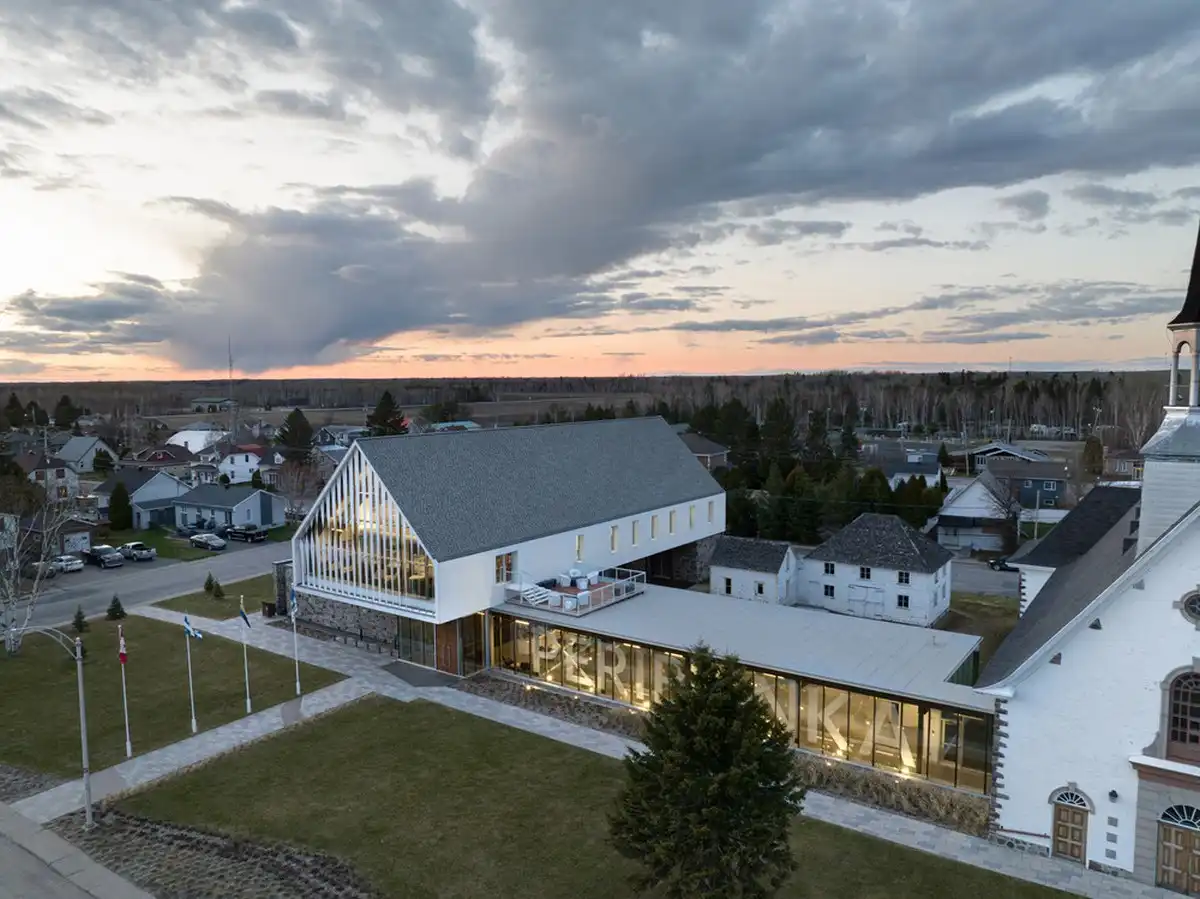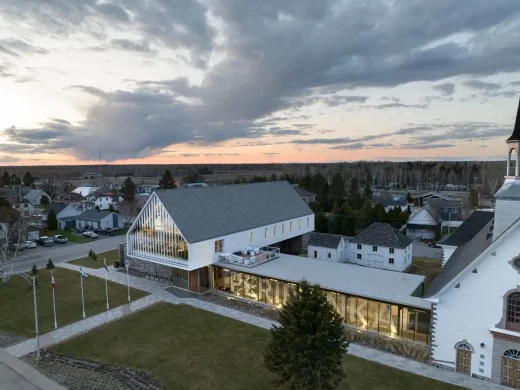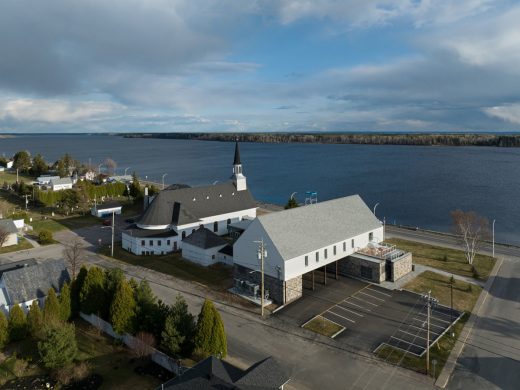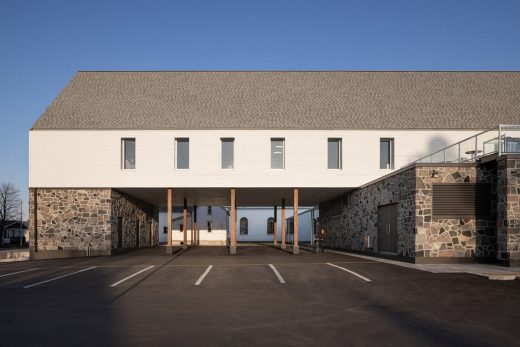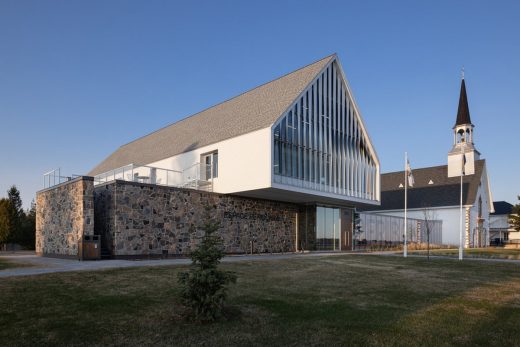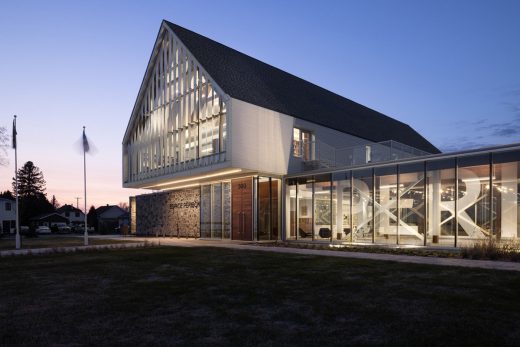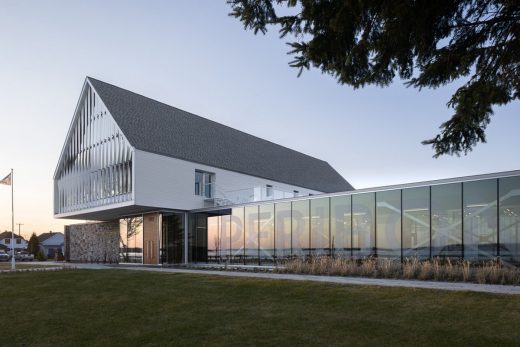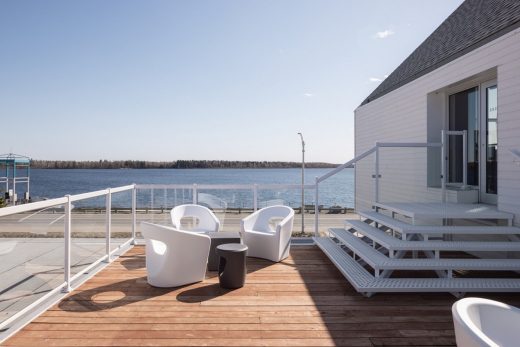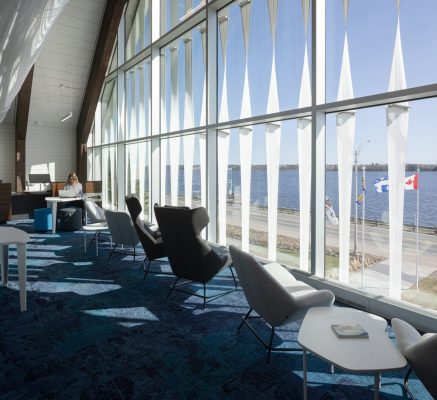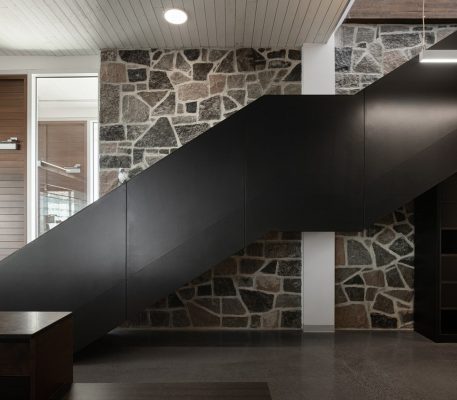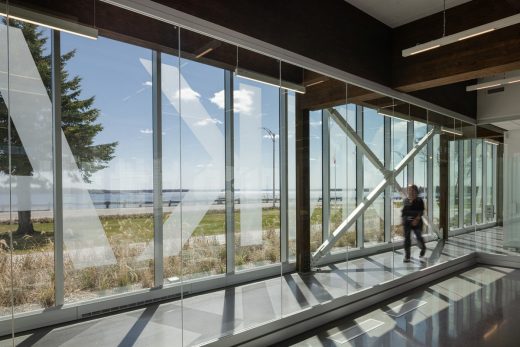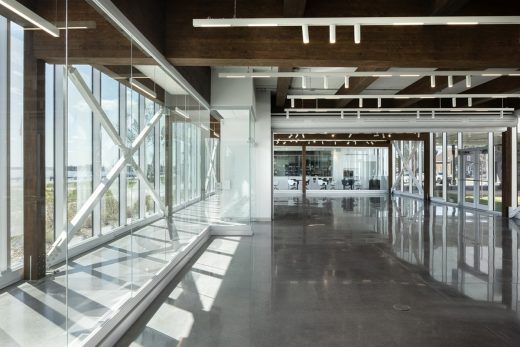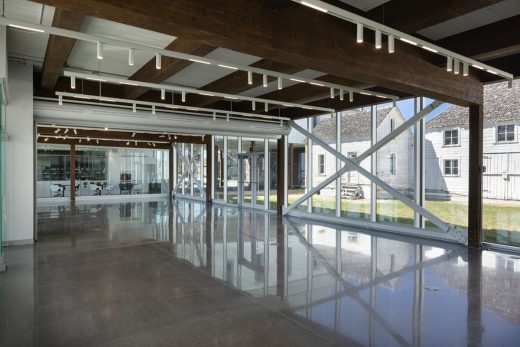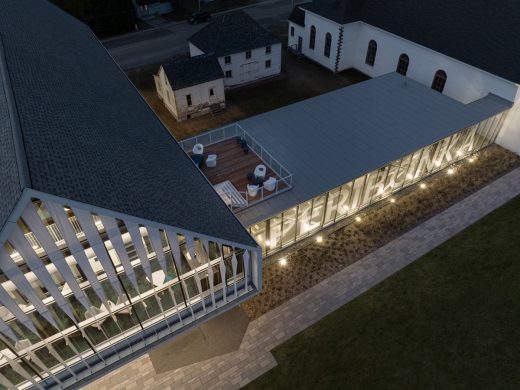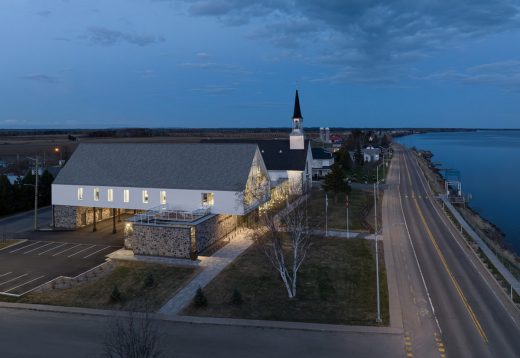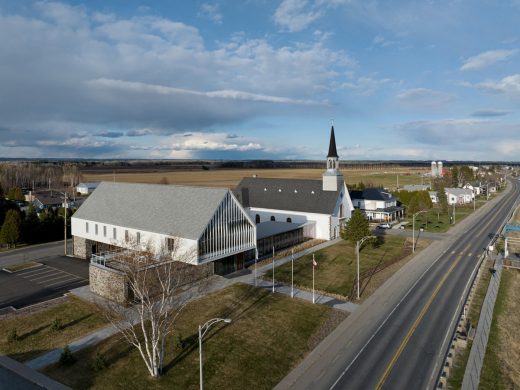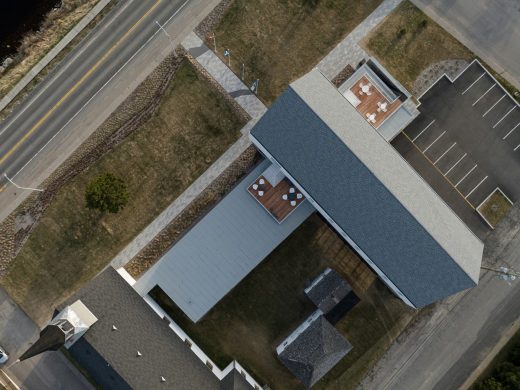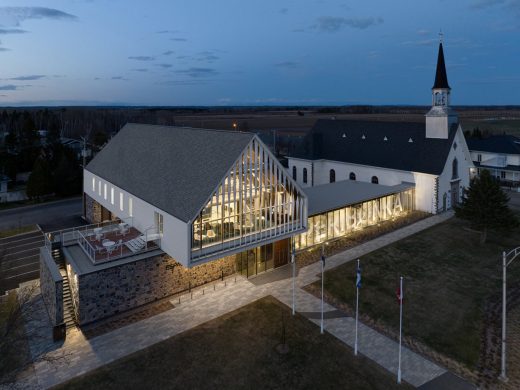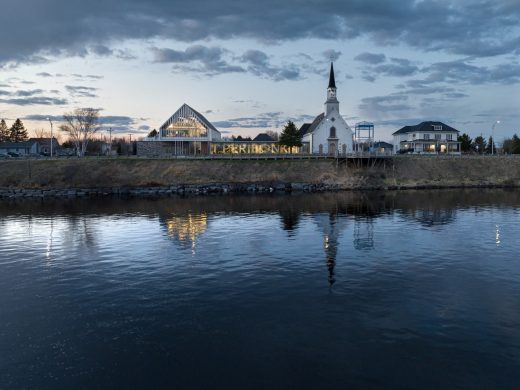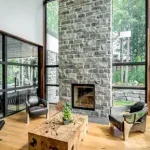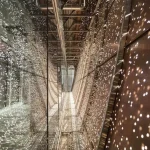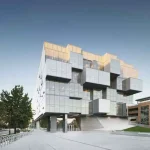Espace Péribonka, School building developmenet, Québec real estate, Canadian architecture photos
Espace Péribonka in Chicoutimi, Québec
July 3, 2024
Architects: Maîtres d’Œuvre Architectes (MDO)
Location: Péribonka, Chicoutimi, Québec, Canada
Photos: Stéphane Groleau
Espace Péribonka, QC
Espace Péribonka: A beaming cultural landmark on the banks of Lac Saint-Jean
Maîtres d’Œuvre Architectes (MDO), a firm combining decades of experience to apply its unique architectural signature to bespoke projects, proudly presents Espace Péribonka, a contemporary consolidation of history and culture in the village of Péribonka, on the banks of Quebec’s Lac Saint-Jean. Founded in 1888, the Village of Péribonka is home to approximately 500 residents, but its historic and cultural significance as a colonial settlement extends well beyond its tiny stature.
The development of the Péribonka tourist site represents a $17 million, multi-governmental investment in a multifunctional complex, a new fire station, and a rejuvenation of the Louis-Hémon Museum. MDO was awarded the mandate as part of a public tender process, presenting their conceptual vision as a fresh new approach to previous proposals. Before embarking on a final design, the firm entered into extensive meetings with the project’s multiple stakeholders to gain an intimate understanding of the nature of the project, and the diverse needs and expectations of those it will serve.
After receiving carte blanche approval, MDO focused on infusing a ‘WOW’ effect into their design of a project that would integrate into the fabric of the town and its stunning natural surroundings. The project included the preservation and rejuvenation of existing buildings, including a church that was designated as the new home of the museum. Along with its community requirements, a key focus of Espace Péribonka was to develop an appealing tourist destination within the core of the municipality. That focus was achieved through the design of multifunctional spaces that address all stakeholder needs, with transparency and seamless connections between the buildings and spaces of the site.
Adding to the challenge, MDO assisted the client and worked with the Quebec Ministry of Culture to gain permission to relocate an existing cultural heritage structure to the new site. Maison Samuel-Bédard, a historic home built in 1903 approximately 6 kilometres from the Espace Péribonka, is symbolic of early colonial settlement in the region. To address the ambitious proposal, the parties agreed upon a temporary declassification of the heritage site in order to relocate it to a new protective inner courtyard at Espace Péribonka, and then reclassifying it in its original splendour.
“One of the biggest challenges in addressing government concerns was to ensure that the heritage site would remain visible in a setting of contemporary attractions,” explains Alexandre Simard, designer at MDO. “By creating a fully glazed corridor connecting the two bookend buildings of the site, we provided visibility through to the inner courtyard where Maison Samuel-Bédard now stands.”
The transparent corridor links the church and museum with the newly constructed Town Hall, with the latter housing civic functions and services including a library, administrative offices, and more. At the onset of the project, the client commissioned studies to assess the condition of existing buildings, and it was determined that the existing Town Hall had become increasingly dysfunctional due to structural decline. In response, MDO erected a bright, lively, and spacious new Town Hall to host the municipal library and a variety of community organizations and functions.
A major challenge to MDO’s design concept was that it had to be articulated within the framework of multiple environmental considerations, including natural elements and noise pollution inherent to the site’s location along a major regional access road. In keeping with the firm’s embrace of extensive transparency for the project, they developed a glass curtain wall as an inviting exposé of the new library.
To address the consequential presence of direct sunlight, the firm collaborated with Sollertia to develop custom sunscreens to protect the interior, while taking into account the strength and direction of prevailing winds, as well as preserving its panoramic views.
As a result, the glass curtain wall offers not only transparency into the interior, but also breathtaking perspectives outward upon the Péribonka River, a major tributary of Lac Saint-Jean. The reflection of the sky on the glass curtain wall transposes a lightness that complements the modern volume and its natural stone base, creating an architectural balance within the built heritage.
“Although Espace Péribonka is in the heart of a village, with beautiful panoramic views along the river, environmental factors played a very significant role in ensuring the site’s tranquility,” adds Alexandre Simard. “Omnipresent winds informed many aspects of the building designs, and we created a low-lying barrier wall to absorb traffic noise emanating from the busy regional road in front.”
In addressing the multiple environmental conditions, the firm selected materials for the envisioned structures carefully. Steel was used to strengthen structures removed from public visibility, as well as to reinforce the floor of the main facade and its cantilevered beams. Wood is also applied abundantly, leveraging both its local availability and its status as a sustainable development product. The new library and multifunctional room are constructed of laminated spruce wood beams and columns, and wood is also applied to the rear extension of a large gable roof, where wooden trusses support its load-bearing walls. As an aesthetic complement, exposed glulam beams and columns were strategically exposed for public consumption, providing a warm, welcoming, and comfortable environment.
In linking the rebuilt environment with the contemporary new volume, MDO incorporated black Péribonka granite at its base, paying homage to the regionalist architecture of the Saint-Édouard de Péribonka church, originally constructed in 1948. The glazed south-facing façade of the new structure also incorporates the proportions and shapes of the church, including the width, depth, height, and roof slopes. To provide outdoor spaces with protection from wind and rain, the firm also integrated a cantilever over the front and rear of the building.
MDO’s architectural signature has been embraced by all of the project’s stakeholders, including Provincial and Federal government agencies. The firm’s innovative design solutions have addressed all expressed concerns, and the finished product is a new source of pride for the small, close-knit community. In the end, the project expanded the boundaries of the traditional client-firm relationship to form deeper bonds than most conventional mandates.
“The concept we developed was powerful, but the key to ensuring its successful execution was the unconditional support we received from the community,” notes Carl Hovington, architect and project manager at MDO. “Each project begins with its own particularities and architectural identity, and we leveraged our experience and expertise to create something truly unique.”
Construction of the project began in 2020, and the main components of the Espace Péribonka tourist site were completed in 2023. The firm is now engaged in the rejuvenation of the Louis-Hémon Museum, which is scheduled for completion in 2024. On the fringes of the main site, the firm also erected a new fire station that is incorporated into the project’s consolidated civic functions. In addition to the aesthetic beauty and functionality of the new complex, its combined services provide the municipality with economies of scale and maximization of resources. Accordingly, Espace Péribonka now sits at the crossroads of tourism, gatherings, and essential services, and is a focal point of the social and cultural life of the community. The municipality hopes to attract 30,000 visitors annually to Espace Péribonka, including regional day trippers and international visitors drawn to its historical, cultural, and ecological attractions.
The project has been widely praised for its design and innovation, and for its integration into the community. Espace Péribonka has been recognized as a finalist for a Municipal Leadership Award from the Federation of Quebec Municipalities, as well as for an urban planning award from the Quebec Ministry of Municipal Affairs and Housing. The project has also been cited as a reference for future multifunctional projects requiring cooperation and approval by multiple government bodies.
“We feel a particularly great sense of pride in completing this project,” concludes Carl Hovington. “While carrying out the project, we developed a special attachment to the community and its inhabitants, who we hope will enjoy Espace Péribonka for many years to come.”
Word from the Municipality of Péribonka
The project stems from the completion of strategic planning for the Louis-Hémon Museum. At the same time, the Municipality of Péribonka submitted a request for financial assistance for the construction of a new fire station. To follow up on the study, the overall reality of the municipality was taken into account and it was decided to bring the various local projects into a single, larger-scale project which would become Chantier tourisme Péribonka.
Over the following years, several public presentations, as well as presentations to representatives of organizations, took place to ensure that the Péribonka tourist site project achieved consensus in the community. With the support of the population and local organizations, the Municipality of Péribonka and the Louis-Hémon Museum joined forces and launched Chantier tourisme Péribonka, an infrastructure project that will offer a distinctive tourist experience linked to culture and nature. The project brings together six local partners: the Municipality of Péribonka, the Péribonka Economic Support Corporation, Fabrique Saint-Édouard-de-Péribonka, Réseau Biblio, the Péribonka Fire Department, and the Louis-Hémon Museum.
Espace Péribonka in Québec, Canada – Building Information
Architects: Maîtres d’Œuvre Architectes (MDO) – https://www.mdoarchitectes.com/
Project Name: Espace Péribonka
Location: Péribonka, Quebec, Canada
Client: Municipality of Péribonka
Architects/Designers: Les Maîtres d’Oeuvre Architects (MDO)
Project Manager: Carl Hovington, Architect
Designer: Alexandre Simard, Architect
Collaborators: Sollertia (Tensioned Fabric Sunshades)
Engineer: Unigec
Landscape Architect: André Arata, Stantec
Project Sector: Institutional
Budget: $17,000,000.00
Project Completion Date: May 2023
Photographer: Stéphane Groleau
About Maîtres d’Œuvre Architectes (MDO)
In 1993, architects Carl Hovington and Luc Gauthier committed themselves to perpetuating the tradition of avant-garde excellence established by their predecessors, and to ensuring the continuity of the Les Maîtres d’Œuvre firm. The current architectural approach and philosophy of MDO have emerged from the combination of the company’s heritage and contemporary ideas and techniques.
Today, MDO comprises a team of experienced professionals who excel in finding innovative solutions and meeting the various challenges of each project. The company stands out with a research-based approach that allows it to meet many of the technical and financial requirements of a project right from the start. Its bold approach has evolved into a unique architectural signature that it applies to all its ambitious projects.
About Péribonka
The municipality of Péribonka has a history intimately linked to the river that winds through its landscape. Its original Algonquin name, pelipoko (a variant being pelipaukau), means ‘river digging in the sand, where the sand moves.’
The Péribonka River is the most important tributary of Lac Saint-Jean. The village of Péribonka came into existence in 1888, during the final phase of colonization of Lac Saint-Jean, when the families of Édouard Niquet and Édouard Milot settled there. This episode would go on to circulate worldwide in the pages of ‘Maria Chapdelaine,’ a story written by the Breton author Louis Hémon.
Since the publication of the novel in 1921, there has been great fascination with the heroic life of the Péribonka settlers, who tirelessly pursued the challenging task of ‘making the land.’ While the novel ‘Maria Chapdelaine’ allowed the municipality to establish itself on the world stage, the village has also been recognized since 1955 as the official starting point of the prestigious International Crossing of Lac Saint-Jean.
Photographer: Stéphane Groleau
Espace Péribonka, Chicoutimi, Québec information / images received 030724 v2com newswire
Location: Quebec, Canada
Québec Architecture
Québec Architecture
Montreal Architecture Designs – chronological list
BALNEA spa and reserve thermale, Bromont
Architecture: MacKay-Lyons Sweetapple Architects Ltd
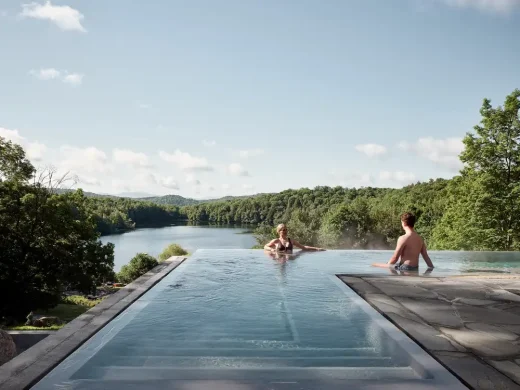
photo : James Brittain
BALNEA spa and reserve thermale, Bromont, Quebec
École secondaire du Bosquet, Drummondville, Québec, Canada
Architecture: ABCP, Menkès Shooner Dagenais LeTourneux and Bilodeau Baril Leeming Architectes
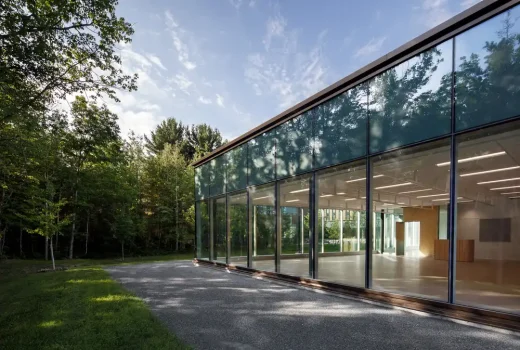
photo : Séphane Brügger
Bosquet High School, Drummondville, Québec
Montreal Architectural Tours
Montreal Architecture Walking Tours by e-architect
Canadian Building Designs
Comments / photos for the Espace Péribonka, Chicoutimi, Québec, Canada designed by Agence Spatiale, Appareil Architecture and BGLA architecture page welcome

